- Joined
- Nov 29, 2016
- Messages
- 5,674
- Points
- 63
https://mil.news.sina.com.cn/jssd/2019-03-07/doc-ihrfqzkc1829485.shtml
美国海军新报告探讨如何对抗中国 结论是这样的
2019年03月07日 07:55 新浪军事
288
最近,美国“战略与预算中心”向国会提交了一份新的报告,对于未来美国海军航空母舰舰载机联队的发展做了新的展望。
这份报告的标题是《重夺海上制高点:航母舰载机联队如何向大国竞争环境转变》,本篇报告的作者当中包括多位曾在美国海军舰载机部队担任指挥员和飞行员的技术专家,其提出的目标某种程度上也反映出了美国海军的想法,对于未来其舰载航空兵部队的发展有着一定的指导意义。
下面几天,我们对这份报告进行深度的解读。毕竟一方面,这个发展计划是针对我们的,我们有必要了解对手未来将拥有什么样的作战能力。另一方面,对于中国海军,“他山之石可以攻玉”,未来我国海军也将建设以航空母舰为核心的攻防一体的作战力量,从美军如何研究未来航母舰载机联队组成,或许对我们未来的航母舰载机发展方向也有意义。
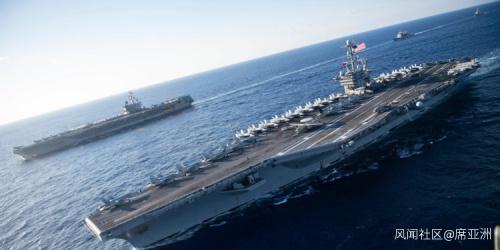
美国海军航母编队
文章开篇,回顾航母舰载航空兵的发展历程,指出航母具有旺盛生命力的一个重要原因就是随着舰载机的发展和多样化,可以灵活的适应不同时代和环境。但在冷战结束后的四分之一世纪里,航母及其舰载机的发展,却是在强调低成本和多样化。在新世纪应对中俄崛起的大国竞争环境视角中看,今天的美国航母打击大队在航程、耐久力、生存力、以及对抗大国军队的特定能力方面存在缺陷。通过对舰载机运用方式进行调整已经无法适应这样的需求,现在海军的领导层应该开始考虑向海军航空兵进一步投资,或者将投资在那些相对无关紧要方面的资金拉回到这些最急迫的方面来。
被推迟的变革
在航母发展的早期时代,航母最初担负的是舰队侦察任务,但随着舰载机性能的发展,她最终变成了主要的反舰投送手段。同时这也让试图保护己方舰队的敌军将航母视为首要打击目标,因此美国海军航空兵转为以防空作战为主,大量部署防空战斗机。在战争后期,越来越多的飞机在“跃岛作战”中扮演了对岸攻击的角色,但因为此时美军已经拥有超过100艘航母,因此仍有足够的防空兵力。
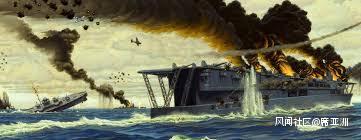
在太平洋战争前半期,珊瑚海、中途岛战役中, 由于双方舰载机兵力可以说是半斤八两,所以胜负往往取决于谁先发先对方并抢先放飞致命的攻击机群
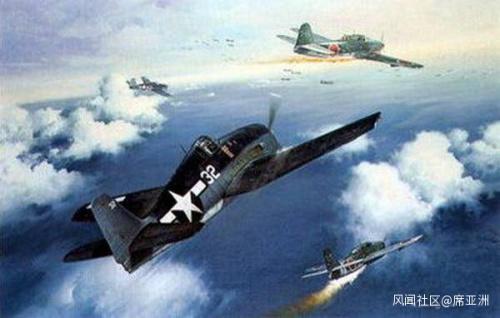
但到了战争中期,及时实现了完美的抢先发现,抢先放飞攻击机群……还是被猎火鸡了……
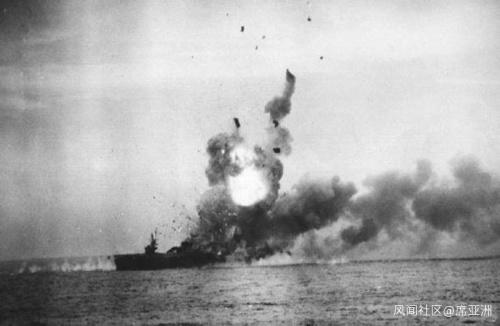
二战后期,日本海军的自杀机某种意义上类似于现代的反舰巡航导弹,能够在很远的距离上发起攻击
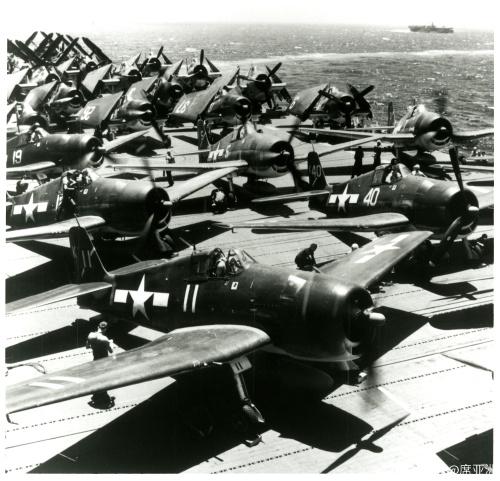
美军因此开始组织大规模的制空巡逻作战,这也是今天美国DCA CAP战术的起源
二战后,随着攻防手段的进一步发展,面对苏联的核潜艇,美国海军开始重视反潜作战,部署了反潜飞机;在朝鲜战争和越战中,海军舰载机联队里出现了专职的攻击机;70年代后,美国海军开始部署多用途战斗机、预警机和电子战飞机。
到了今天,因为反恐战争的需要,若干种对于舰队在大国对抗环境下必不可少的用途单一的飞机退出现役,例如S-3反潜机和F-14战斗机,海军现在不得不使用F/A-18系列战斗机。在21世纪的第二个十年结束前,这种趋势发展到巅峰,只有F\A-18、E-2D和MH-60直升机来执行各种各样的作战任务。
使用多用途飞机确实能够减少后勤成本,提高效率,并且提高航母执行多种任务的能力。但是,目前的这种舰载航空兵的结构,无法适应大国对抗的环境,不论是对抗中俄这样的强国,或者对付那些正在努力将更多新型作战能力投入实用的区域强国,如朝鲜和伊朗。这些潜在的假想敌的反舰、防空和水下威胁日益增强,这需要新的作战理念,并且在舰载机联队中增加更多的机型。
新战略、新态势和新行动理念
2018年的《美国国防战略》将注意力集中在对付中俄对美国利益的威胁上。而此前的战略要求对付的则是弱小得多的敌人,当时美国强调的是威慑、拖延、拒止,最终击败敌方的进攻。采取这一战略的前提是,敌人需要相当的时间来进行战争的准备,这种策略在对付伊拉克的沙漠风暴行动、对付塞尔维亚的联军行动,以及在阿富汗的持久自由行动中都发挥了其作用。
但是现在,这种策略无法生效。例如,如果中国决心对日本动用武力解决钓鱼岛争端,那么解放军海空兵力只需几个小时就可以抵达冲突海域,建立制海、制空权。同样,俄罗斯如果要进攻拉脱维亚,其西部军区只需要几个小时就能占领里加。在这种情况下,美国想要干涉的话,按照后冷战时代的战略,需要几个星期到几个月才能做出反应,而到那时,就要面临敌方大量的远程传感器、以及防空和反舰火力。
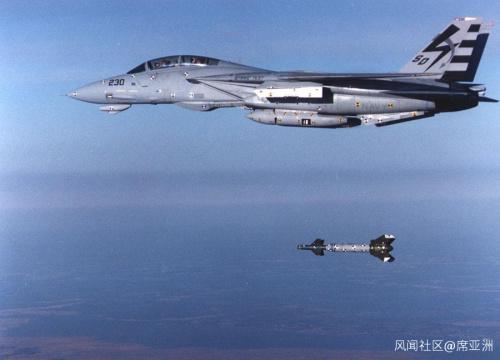
虽然F-14D战斗机在其服役最后也进行了“炸弹猫”改装,但它仍然是一种制空战斗机,对地攻击的挂载条件不佳,而且使用成本还是比较昂贵,最终含泪退役……
按照新的国防战略,美军必须转型依靠前沿部署的海军,联合前沿部署的美军和盟友的陆、空兵力,以及战略轰炸机的支援,完成阻碍、拒止和击败进攻的任务。这意味着美军必须具备极强的在对抗性环境下的生存能力,因为中国和俄罗斯将使用发动大规模的导弹齐射等远程打击手段。这意味着,美国海军航母编队必须在敌方导弹威胁相对较弱的位置来发起攻击,这意味着打击距离要达到800-1200海里,具体的距离要视地形和具体的威胁情况而定,以在敌方导弹威胁程度和我方打击效能之间取得平衡。
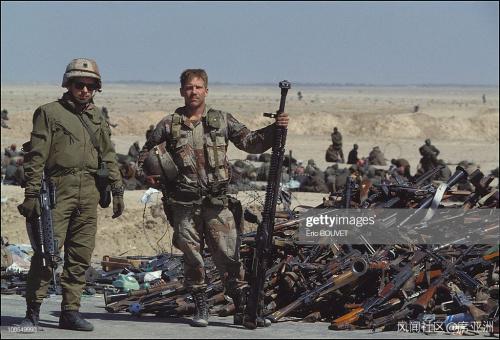
过去25年来,美军醉心于如何重演一场更完美的1991年海湾战争……
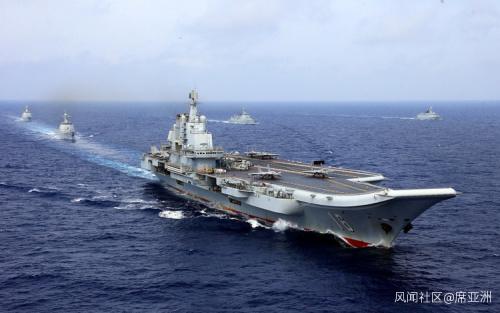
可是……
大国竞争环境意味着,美国海军航母打击大队需要为以下三种情况做准备:
在较小规模的行动,在较远距离上突击大国对手高度设防的单个目标,这种情况下进行对陆打击和反舰攻击的武器投射数量少于200枚,且需要组织电子战或掩护作战,以及反潜作战;
在与大国边缘地带进行持续性行动,例如在菲律宾或南中国海上与中国或者在挪威海与俄罗斯发生冲突;
与地区强国进行全面冲突,例如对伊朗和朝鲜进行行动,对手缺乏远程监视、防空和反舰打击能力。
防空、反导与侦察监视、目标搜索能力
中国和俄罗斯军队目前拥有的,能够对美国航母和岸基基地实施攻击的精确制导导弹的数量正在增长,并且最终将会压倒美军的防御,即使国防部承诺的高效反导系统被部署到位,包括定向能武器和短程拦截弹。
为了在高度对抗性环境中生存,美国军队将采取行动,以弥补舰载和岸基防空系统的不足,包括拦截飞行中的导弹和在敌方导弹发射出来前,攻击敌方导弹发射平台。因此,舰载机联队需要需要回复冷战期间确立的远程防空战斗行动概念,以击落敌方搭载反舰导弹的飞机。远程防空战斗需要让战斗机在最可能遭到的攻击轴线方向上,距离航母超过200海里外进行巡逻,并且得到E-2C预警机和S-3加油机的支持。
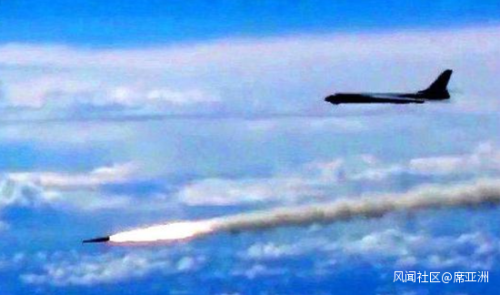
轰-6发射的鹰击-12导弹射程已经达到600公里,而尺寸比它更大,射程更远的远程超音速反舰导弹鹰击-XXX也正在发展,其射程将达到2000公里
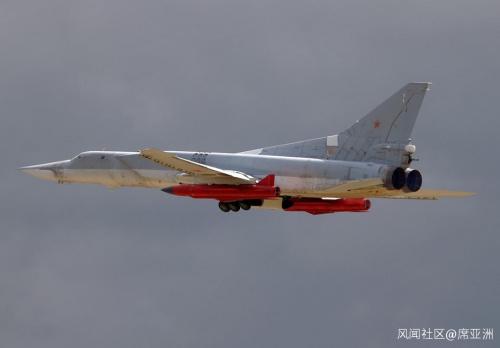
俄罗斯已经开始装备在Kh-22基础上研制的Kh-32,其射程也达到了1000公里之遥
但现在的反舰巡航导弹已经具备了500海里射程,到2040年,它们可能达到陆攻巡航导弹1000海里的射程。尽管中俄的轰炸机可能无法在如此的距离上探测到美国舰队或者地面目标,但这两个对手都拥有复杂的航空、航天和第三方监视和目标搜索手段。为了对抗不断增强的导弹威胁,美国海军需要建立基于分布式技术的21世纪版的远程制空战斗能力。
在这种新的防空概念中,航母舰载机联队的防御性空战巡逻(DCA CAP)任务需要在距离航母800-1000海里的距离上展开。而且还需要再组织第二层的制空巡逻行动,来进一步削弱敌方反舰导弹齐射,此外还需要进一步增强舰艇或岸基的防空能力。
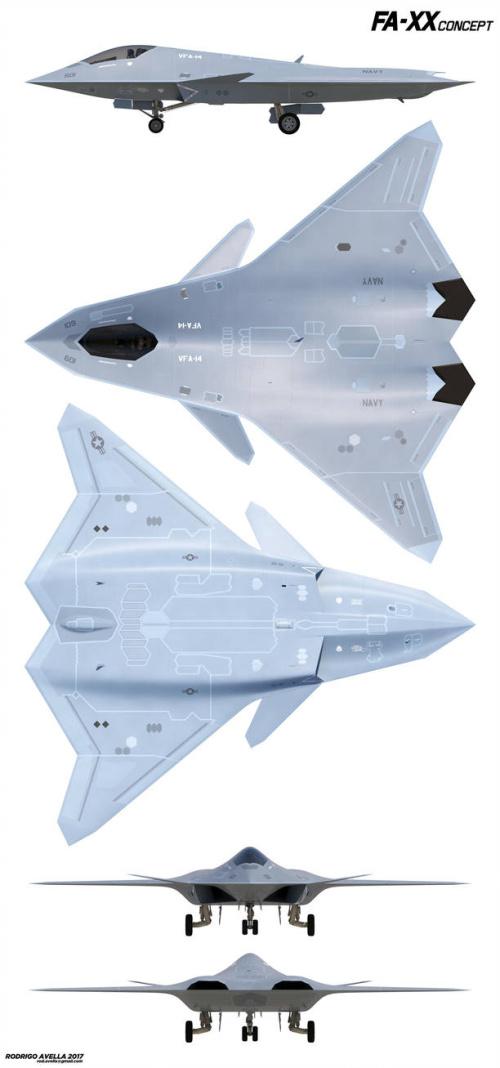
波音位美国海军设计的F/A-XX战斗机,或者说“第六代”战斗机在隐身方面将比现有飞机有更大的提高,当然从现在设想的外形来看……你这真不是把歼-20的尾翼给拔了?
为了应对在最可能遭到攻击轴线方向之外发起的攻击,还需要组织侦察监视和目标搜索制空巡逻(ISR&T CAP),其任务是搜索和锁定敌方飞机,以便让航母打击大队中的防空舰、地面远程防空火力、或者制空战斗机来进行远程拦截。
而执行未来的防空和反导作战(AMD),还需要拥有一种远程、长留空时间,并在对抗性环境中有足够生存能力的飞机。这些飞机要具备通过被动手段实施侦察监视的能力,还要拥有远程空空导弹,以及定向能武器,以在不被敌方发现的情况下,击落敌方的轰炸机,这意味着执行防空任务的战斗机的速度和机动性方面的要求可以有所放宽。(作者署名:席亚洲)
The US Navy’s new report explores how to fight against China. The conclusion is this.
March 07, 2019 07:55 Sina Military
288
Recently, the US Center for Strategic and Budget submitted a new report to Congress, which gave a new outlook for the future development of the US Navy aircraft carrier carrier fleet.
The title of this report is "Regaining the commanding heights of the sea: how the carrier carrier fleet can change to a competitive environment in a big country." The authors of this report include several techniques that have served as commanders and pilots in the US Navy carrier aircraft units. Experts, their proposed goals also reflect the idea of the US Navy to some extent, and have certain guiding significance for the future development of its carrier-based aviation units.
In the next few days, we will have an in-depth interpretation of this report. After all, on the one hand, this development plan is aimed at us, we need to understand what kind of combat capability the opponent will have in the future. On the other hand, for the Chinese navy, "the stone of other mountains can attack jade". In the future, the Chinese navy will also build an operational force that combines the attack and defense with the aircraft carrier as the core. From the US military how to study the composition of the future aircraft carrier aircraft fleet, perhaps The future direction of our aircraft carrier carrier is also meaningful.
US Navy aircraft carrier formation
At the beginning of the article, reviewing the development history of aircraft carrier airborne aircraft, it is pointed out that an important reason for the carrier's vitality is that it can flexibly adapt to different times and environments with the development and diversification of carrier aircraft. But in the quarter century after the end of the Cold War, the development of aircraft carriers and their carrier-based aircraft was focused on low cost and diversification. In the new century, in the perspective of the competitive environment of the big countries that have emerged from the rise of China and Russia, today's US aircraft carrier strike squad has flaws in terms of voyage, durability, survivability, and specific capabilities against the army of the great powers. The adjustment of the carrier's mode of operation has been unable to adapt to such needs, and now the Navy's leadership should begin to consider further investment in naval aviation, or to invest in those relatively insignificant aspects of the funds back to these most urgent aspects. .
Delayed change
In the early days of aircraft carrier development, the aircraft carrier was initially responsible for the fleet reconnaissance mission, but with the development of carrier aircraft performance, she eventually became the main means of anti-ship delivery. At the same time, this also makes the enemy forces trying to protect their own fleets regard the aircraft carrier as the primary target. Therefore, the US Naval Air Force turned to air defense operations and deployed a large number of air defense fighters. In the later stages of the war, more and more aircraft played the role of a counter-attack in the "Yuedao combat", but because the US military already has more than 100 aircraft carriers, there are still enough air defense forces.
In the first half of the Pacific War, in the Battle of Coral and Midway, because the carrier forces of both sides can be said to be half a catty, the winners and losers often depend on who first sends the other and preemptively launches the deadly attack aircraft.
But in the middle of the war, the perfect first-time discovery was realized in time, and the attacking aircraft group was first released... or the turkey was hunted...
In the latter part of the Second World War, the Japanese Navy’s suicide machine was similar in some sense to modern anti-ship cruise missiles, capable of launching attacks over long distances.
The US military has therefore begun to organize large-scale air patrol operations, which is also the origin of the US DCA CAP tactics today.
After the Second World War, with the further development of offensive and defensive means, in the face of the Soviet nuclear submarine, the US Navy began to attach importance to anti-submarine warfare and deployed anti-submarine aircraft; in the Korean War and the Vietnam War, a full-time attack aircraft appeared in the Navy carrier aircraft wing; After the 1970s, the US Navy began deploying multi-role fighters, early warning aircraft, and electronic warfare aircraft.
Today, because of the needs of the war on terror, several types of aircraft that are indispensable for the fleet’s use in a large country’s confrontational environment, such as the S-3 anti-submarine aircraft and the F-14 fighter jet, have now had to use the F/A-18. Series fighters. Before the end of the second decade of the 21st century, this trend reached its peak, with only the F\A-18, E-2D and MH-60 helicopters performing a variety of combat missions.
The use of multi-purpose aircraft can indeed reduce logistics costs, increase efficiency, and increase the ability of aircraft carriers to perform multiple tasks. However, the current structure of this carrier-based aviation cannot adapt to the confrontational environment of big countries, whether it is against a powerful country like China and Russia, or against regional powers that are trying to put more new combat capabilities into practical use, such as North Korea and Iran. The anti-ship, air defense and underwater threats of these potential imaginary enemies are increasing, which requires new operational concepts and the addition of more aircraft to the carrier aircraft wing.
New strategies, new trends and new action concepts
The 2018 US Defense Strategy focuses on dealing with the threat of Sino-Russian interests in the United States. The previous strategy required to deal with a much weaker enemy. At that time, the United States emphasized deterrence, delay, rejection, and ultimately defeated the enemy's offensive. The premise of adopting this strategy is that the enemy needs considerable time to prepare for the war. This strategy has played its role in dealing with the Operation Desert Storm in Iraq, the coalition operations against Serbia, and the enduring freedom of movement in Afghanistan.
But now, this strategy can't take effect. For example, if China is determined to use force against Japan to resolve the Diaoyu Islands dispute, then the PLA air and sea forces can reach the conflicted waters in a few hours and establish sea and air rights. Similarly, if Russia wants to attack Latvia, its western military region will only take a few hours to occupy Riga. Under this circumstance, if the United States wants to interfere, it will take several weeks to several months to respond according to the post-Cold War era strategy. At that time, it will face a large number of remote sensors and air defenses. Anti-ship firepower.
Although the F-14D fighter aircraft also carried out the "bomb cat" modification at the end of its service, it is still a kind of air-to-air fighter. The grounding attack has poor mounting conditions, and the cost of use is relatively expensive, and finally the tears are retired... ...
In accordance with the new national defense strategy, the US military must transform its navy, which relies on cutting-edge deployments, and combine the land and air forces of US and allies deployed at the forefront, as well as the support of strategic bombers, to complete the task of obstructing, rejecting, and defeating the offensive. This means that the US military must have a strong ability to survive in a confrontational environment, because China and Russia will use long-range strikes such as launching large-scale missile volleys. This means that the US Navy aircraft carrier formation must launch an attack at a relatively weak enemy missile position, which means that the strike distance is 800-1200 nautical miles. The specific distance depends on the terrain and the specific threat situation. A balance is struck between the level of enemy missile threats and our strike effectiveness.
Over the past 25 years, the US military has been fascinated with how to repeat a more perfect 1991 Gulf War...
But...
The competitive environment of big countries means that the US Navy aircraft carrier strike team needs to prepare for the following three situations:
In smaller-scale operations, a single target that is highly fortified by a large country opponent at a long distance. In this case, the number of weapons projected for land attack and anti-ship attack is less than 200, and it is necessary to organize electronic warfare or cover operations. And anti-submarine warfare;
Conducting ongoing actions on the fringes of major powers, such as conflicts with China in the Philippines or South China Sea or Russia in the Norwegian Sea;
Comprehensive conflicts with regional powers, such as Iran and North Korea, lacking remote surveillance, air defense and anti-ship strike capabilities.
Air defense, anti-missile and reconnaissance surveillance, target search capability
The number of precision-guided missiles currently available to Chinese and Russian armies capable of attacking US aircraft carriers and shore-based bases is growing and will eventually overwhelm the US military's defenses, even if the Department of Defense's promised high-performance anti-missile systems are in place, including Directional energy weapons and short-range interceptors.
In order to survive in a highly confrontational environment, the US military will take action to compensate for the deficiencies of the shipboard and shore-based air defense systems, including intercepting in-flight missiles and attacking enemy missile launch platforms before enemy missiles are launched. Therefore, the carrier aircraft wing needs to respond to the concept of long-range air defense combat operations established during the Cold War to shoot down enemy aircraft carrying anti-ship missiles. Long-range air defense combat requires the fighter to patrol more than 200 nautical miles from the aircraft carrier in the direction of the most likely attack axis, and is supported by the E-2C early warning aircraft and the S-3 tanker.
The Hawk-6 missile launched by the H-6 has reached a range of 600 kilometers, and the long-range supersonic supersonic anti-ship missile eagle-XXX, which is larger in size, is also developing, and its range will reach 2,000 kilometers.
Russia has begun to equip the Kh-32, which was developed on the basis of Kh-22, and its range has reached 1000 km.
But today's anti-ship cruise missiles already have a range of 500 nautical miles, and by 2040 they may reach a range of 1000 nautical miles for land-attack cruise missiles. Although Chinese and Russian bombers may not be able to detect US fleets or ground targets at such distances, both rivals have sophisticated aerospace, aerospace and third-party surveillance and target search methods. In order to counter the ever-increasing missile threat, the US Navy needs to build a 21st century version of long-range air combat capability based on distributed technology.
In this new air defense concept, the defensive air patrol (DCA CAP) mission of the aircraft carrier fleet needs to be carried out at a distance of 800-1000 nautical miles from the aircraft carrier. Moreover, it is necessary to organize a second-level air-to-air patrol operation to further weaken the enemy's anti-ship missile volley. In addition, it is necessary to further enhance the air defense capability of the ship or the shore.
The Boeing F/A-XX fighter jet designed by the US Navy, or the "sixth generation" fighter jet, will have a greater improvement in stealth than the existing aircraft. Of course, from the shape that is now envisaged... you really are not Did the tail of the 歼-20 be pulled out?
In order to deal with attacks that are most likely to be launched outside the direction of the attack axis, it is also necessary to organize reconnaissance surveillance and target search air patrol (ISR & T CAP), the task is to search and lock enemy aircraft, so that the aircraft carrier can fight the air defense in the brigade Ships, ground long-range air defense firepower, or air defense fighters for remote interception.
The implementation of future air defense and anti-missile operations (AMD) also requires an aircraft that has long-range, long-duration time and sufficient viability in a confrontational environment. These aircraft must have the ability to conduct reconnaissance surveillance through passive means, as well as long-range air-to-air missiles and directed energy weapons to shoot down enemy bombers without being discovered by the enemy, which means fighters performing air defense missions. The speed and mobility requirements can be relaxed. (Author's signature: Xi Asia)
美国海军新报告探讨如何对抗中国 结论是这样的
2019年03月07日 07:55 新浪军事
288
最近,美国“战略与预算中心”向国会提交了一份新的报告,对于未来美国海军航空母舰舰载机联队的发展做了新的展望。
这份报告的标题是《重夺海上制高点:航母舰载机联队如何向大国竞争环境转变》,本篇报告的作者当中包括多位曾在美国海军舰载机部队担任指挥员和飞行员的技术专家,其提出的目标某种程度上也反映出了美国海军的想法,对于未来其舰载航空兵部队的发展有着一定的指导意义。
下面几天,我们对这份报告进行深度的解读。毕竟一方面,这个发展计划是针对我们的,我们有必要了解对手未来将拥有什么样的作战能力。另一方面,对于中国海军,“他山之石可以攻玉”,未来我国海军也将建设以航空母舰为核心的攻防一体的作战力量,从美军如何研究未来航母舰载机联队组成,或许对我们未来的航母舰载机发展方向也有意义。

美国海军航母编队
文章开篇,回顾航母舰载航空兵的发展历程,指出航母具有旺盛生命力的一个重要原因就是随着舰载机的发展和多样化,可以灵活的适应不同时代和环境。但在冷战结束后的四分之一世纪里,航母及其舰载机的发展,却是在强调低成本和多样化。在新世纪应对中俄崛起的大国竞争环境视角中看,今天的美国航母打击大队在航程、耐久力、生存力、以及对抗大国军队的特定能力方面存在缺陷。通过对舰载机运用方式进行调整已经无法适应这样的需求,现在海军的领导层应该开始考虑向海军航空兵进一步投资,或者将投资在那些相对无关紧要方面的资金拉回到这些最急迫的方面来。
被推迟的变革
在航母发展的早期时代,航母最初担负的是舰队侦察任务,但随着舰载机性能的发展,她最终变成了主要的反舰投送手段。同时这也让试图保护己方舰队的敌军将航母视为首要打击目标,因此美国海军航空兵转为以防空作战为主,大量部署防空战斗机。在战争后期,越来越多的飞机在“跃岛作战”中扮演了对岸攻击的角色,但因为此时美军已经拥有超过100艘航母,因此仍有足够的防空兵力。

在太平洋战争前半期,珊瑚海、中途岛战役中, 由于双方舰载机兵力可以说是半斤八两,所以胜负往往取决于谁先发先对方并抢先放飞致命的攻击机群

但到了战争中期,及时实现了完美的抢先发现,抢先放飞攻击机群……还是被猎火鸡了……

二战后期,日本海军的自杀机某种意义上类似于现代的反舰巡航导弹,能够在很远的距离上发起攻击

美军因此开始组织大规模的制空巡逻作战,这也是今天美国DCA CAP战术的起源
二战后,随着攻防手段的进一步发展,面对苏联的核潜艇,美国海军开始重视反潜作战,部署了反潜飞机;在朝鲜战争和越战中,海军舰载机联队里出现了专职的攻击机;70年代后,美国海军开始部署多用途战斗机、预警机和电子战飞机。
到了今天,因为反恐战争的需要,若干种对于舰队在大国对抗环境下必不可少的用途单一的飞机退出现役,例如S-3反潜机和F-14战斗机,海军现在不得不使用F/A-18系列战斗机。在21世纪的第二个十年结束前,这种趋势发展到巅峰,只有F\A-18、E-2D和MH-60直升机来执行各种各样的作战任务。
使用多用途飞机确实能够减少后勤成本,提高效率,并且提高航母执行多种任务的能力。但是,目前的这种舰载航空兵的结构,无法适应大国对抗的环境,不论是对抗中俄这样的强国,或者对付那些正在努力将更多新型作战能力投入实用的区域强国,如朝鲜和伊朗。这些潜在的假想敌的反舰、防空和水下威胁日益增强,这需要新的作战理念,并且在舰载机联队中增加更多的机型。
新战略、新态势和新行动理念
2018年的《美国国防战略》将注意力集中在对付中俄对美国利益的威胁上。而此前的战略要求对付的则是弱小得多的敌人,当时美国强调的是威慑、拖延、拒止,最终击败敌方的进攻。采取这一战略的前提是,敌人需要相当的时间来进行战争的准备,这种策略在对付伊拉克的沙漠风暴行动、对付塞尔维亚的联军行动,以及在阿富汗的持久自由行动中都发挥了其作用。
但是现在,这种策略无法生效。例如,如果中国决心对日本动用武力解决钓鱼岛争端,那么解放军海空兵力只需几个小时就可以抵达冲突海域,建立制海、制空权。同样,俄罗斯如果要进攻拉脱维亚,其西部军区只需要几个小时就能占领里加。在这种情况下,美国想要干涉的话,按照后冷战时代的战略,需要几个星期到几个月才能做出反应,而到那时,就要面临敌方大量的远程传感器、以及防空和反舰火力。

虽然F-14D战斗机在其服役最后也进行了“炸弹猫”改装,但它仍然是一种制空战斗机,对地攻击的挂载条件不佳,而且使用成本还是比较昂贵,最终含泪退役……
按照新的国防战略,美军必须转型依靠前沿部署的海军,联合前沿部署的美军和盟友的陆、空兵力,以及战略轰炸机的支援,完成阻碍、拒止和击败进攻的任务。这意味着美军必须具备极强的在对抗性环境下的生存能力,因为中国和俄罗斯将使用发动大规模的导弹齐射等远程打击手段。这意味着,美国海军航母编队必须在敌方导弹威胁相对较弱的位置来发起攻击,这意味着打击距离要达到800-1200海里,具体的距离要视地形和具体的威胁情况而定,以在敌方导弹威胁程度和我方打击效能之间取得平衡。

过去25年来,美军醉心于如何重演一场更完美的1991年海湾战争……

可是……
大国竞争环境意味着,美国海军航母打击大队需要为以下三种情况做准备:
在较小规模的行动,在较远距离上突击大国对手高度设防的单个目标,这种情况下进行对陆打击和反舰攻击的武器投射数量少于200枚,且需要组织电子战或掩护作战,以及反潜作战;
在与大国边缘地带进行持续性行动,例如在菲律宾或南中国海上与中国或者在挪威海与俄罗斯发生冲突;
与地区强国进行全面冲突,例如对伊朗和朝鲜进行行动,对手缺乏远程监视、防空和反舰打击能力。
防空、反导与侦察监视、目标搜索能力
中国和俄罗斯军队目前拥有的,能够对美国航母和岸基基地实施攻击的精确制导导弹的数量正在增长,并且最终将会压倒美军的防御,即使国防部承诺的高效反导系统被部署到位,包括定向能武器和短程拦截弹。
为了在高度对抗性环境中生存,美国军队将采取行动,以弥补舰载和岸基防空系统的不足,包括拦截飞行中的导弹和在敌方导弹发射出来前,攻击敌方导弹发射平台。因此,舰载机联队需要需要回复冷战期间确立的远程防空战斗行动概念,以击落敌方搭载反舰导弹的飞机。远程防空战斗需要让战斗机在最可能遭到的攻击轴线方向上,距离航母超过200海里外进行巡逻,并且得到E-2C预警机和S-3加油机的支持。

轰-6发射的鹰击-12导弹射程已经达到600公里,而尺寸比它更大,射程更远的远程超音速反舰导弹鹰击-XXX也正在发展,其射程将达到2000公里

俄罗斯已经开始装备在Kh-22基础上研制的Kh-32,其射程也达到了1000公里之遥
但现在的反舰巡航导弹已经具备了500海里射程,到2040年,它们可能达到陆攻巡航导弹1000海里的射程。尽管中俄的轰炸机可能无法在如此的距离上探测到美国舰队或者地面目标,但这两个对手都拥有复杂的航空、航天和第三方监视和目标搜索手段。为了对抗不断增强的导弹威胁,美国海军需要建立基于分布式技术的21世纪版的远程制空战斗能力。
在这种新的防空概念中,航母舰载机联队的防御性空战巡逻(DCA CAP)任务需要在距离航母800-1000海里的距离上展开。而且还需要再组织第二层的制空巡逻行动,来进一步削弱敌方反舰导弹齐射,此外还需要进一步增强舰艇或岸基的防空能力。

波音位美国海军设计的F/A-XX战斗机,或者说“第六代”战斗机在隐身方面将比现有飞机有更大的提高,当然从现在设想的外形来看……你这真不是把歼-20的尾翼给拔了?
为了应对在最可能遭到攻击轴线方向之外发起的攻击,还需要组织侦察监视和目标搜索制空巡逻(ISR&T CAP),其任务是搜索和锁定敌方飞机,以便让航母打击大队中的防空舰、地面远程防空火力、或者制空战斗机来进行远程拦截。
而执行未来的防空和反导作战(AMD),还需要拥有一种远程、长留空时间,并在对抗性环境中有足够生存能力的飞机。这些飞机要具备通过被动手段实施侦察监视的能力,还要拥有远程空空导弹,以及定向能武器,以在不被敌方发现的情况下,击落敌方的轰炸机,这意味着执行防空任务的战斗机的速度和机动性方面的要求可以有所放宽。(作者署名:席亚洲)
The US Navy’s new report explores how to fight against China. The conclusion is this.
March 07, 2019 07:55 Sina Military
288
Recently, the US Center for Strategic and Budget submitted a new report to Congress, which gave a new outlook for the future development of the US Navy aircraft carrier carrier fleet.
The title of this report is "Regaining the commanding heights of the sea: how the carrier carrier fleet can change to a competitive environment in a big country." The authors of this report include several techniques that have served as commanders and pilots in the US Navy carrier aircraft units. Experts, their proposed goals also reflect the idea of the US Navy to some extent, and have certain guiding significance for the future development of its carrier-based aviation units.
In the next few days, we will have an in-depth interpretation of this report. After all, on the one hand, this development plan is aimed at us, we need to understand what kind of combat capability the opponent will have in the future. On the other hand, for the Chinese navy, "the stone of other mountains can attack jade". In the future, the Chinese navy will also build an operational force that combines the attack and defense with the aircraft carrier as the core. From the US military how to study the composition of the future aircraft carrier aircraft fleet, perhaps The future direction of our aircraft carrier carrier is also meaningful.
US Navy aircraft carrier formation
At the beginning of the article, reviewing the development history of aircraft carrier airborne aircraft, it is pointed out that an important reason for the carrier's vitality is that it can flexibly adapt to different times and environments with the development and diversification of carrier aircraft. But in the quarter century after the end of the Cold War, the development of aircraft carriers and their carrier-based aircraft was focused on low cost and diversification. In the new century, in the perspective of the competitive environment of the big countries that have emerged from the rise of China and Russia, today's US aircraft carrier strike squad has flaws in terms of voyage, durability, survivability, and specific capabilities against the army of the great powers. The adjustment of the carrier's mode of operation has been unable to adapt to such needs, and now the Navy's leadership should begin to consider further investment in naval aviation, or to invest in those relatively insignificant aspects of the funds back to these most urgent aspects. .
Delayed change
In the early days of aircraft carrier development, the aircraft carrier was initially responsible for the fleet reconnaissance mission, but with the development of carrier aircraft performance, she eventually became the main means of anti-ship delivery. At the same time, this also makes the enemy forces trying to protect their own fleets regard the aircraft carrier as the primary target. Therefore, the US Naval Air Force turned to air defense operations and deployed a large number of air defense fighters. In the later stages of the war, more and more aircraft played the role of a counter-attack in the "Yuedao combat", but because the US military already has more than 100 aircraft carriers, there are still enough air defense forces.
In the first half of the Pacific War, in the Battle of Coral and Midway, because the carrier forces of both sides can be said to be half a catty, the winners and losers often depend on who first sends the other and preemptively launches the deadly attack aircraft.
But in the middle of the war, the perfect first-time discovery was realized in time, and the attacking aircraft group was first released... or the turkey was hunted...
In the latter part of the Second World War, the Japanese Navy’s suicide machine was similar in some sense to modern anti-ship cruise missiles, capable of launching attacks over long distances.
The US military has therefore begun to organize large-scale air patrol operations, which is also the origin of the US DCA CAP tactics today.
After the Second World War, with the further development of offensive and defensive means, in the face of the Soviet nuclear submarine, the US Navy began to attach importance to anti-submarine warfare and deployed anti-submarine aircraft; in the Korean War and the Vietnam War, a full-time attack aircraft appeared in the Navy carrier aircraft wing; After the 1970s, the US Navy began deploying multi-role fighters, early warning aircraft, and electronic warfare aircraft.
Today, because of the needs of the war on terror, several types of aircraft that are indispensable for the fleet’s use in a large country’s confrontational environment, such as the S-3 anti-submarine aircraft and the F-14 fighter jet, have now had to use the F/A-18. Series fighters. Before the end of the second decade of the 21st century, this trend reached its peak, with only the F\A-18, E-2D and MH-60 helicopters performing a variety of combat missions.
The use of multi-purpose aircraft can indeed reduce logistics costs, increase efficiency, and increase the ability of aircraft carriers to perform multiple tasks. However, the current structure of this carrier-based aviation cannot adapt to the confrontational environment of big countries, whether it is against a powerful country like China and Russia, or against regional powers that are trying to put more new combat capabilities into practical use, such as North Korea and Iran. The anti-ship, air defense and underwater threats of these potential imaginary enemies are increasing, which requires new operational concepts and the addition of more aircraft to the carrier aircraft wing.
New strategies, new trends and new action concepts
The 2018 US Defense Strategy focuses on dealing with the threat of Sino-Russian interests in the United States. The previous strategy required to deal with a much weaker enemy. At that time, the United States emphasized deterrence, delay, rejection, and ultimately defeated the enemy's offensive. The premise of adopting this strategy is that the enemy needs considerable time to prepare for the war. This strategy has played its role in dealing with the Operation Desert Storm in Iraq, the coalition operations against Serbia, and the enduring freedom of movement in Afghanistan.
But now, this strategy can't take effect. For example, if China is determined to use force against Japan to resolve the Diaoyu Islands dispute, then the PLA air and sea forces can reach the conflicted waters in a few hours and establish sea and air rights. Similarly, if Russia wants to attack Latvia, its western military region will only take a few hours to occupy Riga. Under this circumstance, if the United States wants to interfere, it will take several weeks to several months to respond according to the post-Cold War era strategy. At that time, it will face a large number of remote sensors and air defenses. Anti-ship firepower.
Although the F-14D fighter aircraft also carried out the "bomb cat" modification at the end of its service, it is still a kind of air-to-air fighter. The grounding attack has poor mounting conditions, and the cost of use is relatively expensive, and finally the tears are retired... ...
In accordance with the new national defense strategy, the US military must transform its navy, which relies on cutting-edge deployments, and combine the land and air forces of US and allies deployed at the forefront, as well as the support of strategic bombers, to complete the task of obstructing, rejecting, and defeating the offensive. This means that the US military must have a strong ability to survive in a confrontational environment, because China and Russia will use long-range strikes such as launching large-scale missile volleys. This means that the US Navy aircraft carrier formation must launch an attack at a relatively weak enemy missile position, which means that the strike distance is 800-1200 nautical miles. The specific distance depends on the terrain and the specific threat situation. A balance is struck between the level of enemy missile threats and our strike effectiveness.
Over the past 25 years, the US military has been fascinated with how to repeat a more perfect 1991 Gulf War...
But...
The competitive environment of big countries means that the US Navy aircraft carrier strike team needs to prepare for the following three situations:
In smaller-scale operations, a single target that is highly fortified by a large country opponent at a long distance. In this case, the number of weapons projected for land attack and anti-ship attack is less than 200, and it is necessary to organize electronic warfare or cover operations. And anti-submarine warfare;
Conducting ongoing actions on the fringes of major powers, such as conflicts with China in the Philippines or South China Sea or Russia in the Norwegian Sea;
Comprehensive conflicts with regional powers, such as Iran and North Korea, lacking remote surveillance, air defense and anti-ship strike capabilities.
Air defense, anti-missile and reconnaissance surveillance, target search capability
The number of precision-guided missiles currently available to Chinese and Russian armies capable of attacking US aircraft carriers and shore-based bases is growing and will eventually overwhelm the US military's defenses, even if the Department of Defense's promised high-performance anti-missile systems are in place, including Directional energy weapons and short-range interceptors.
In order to survive in a highly confrontational environment, the US military will take action to compensate for the deficiencies of the shipboard and shore-based air defense systems, including intercepting in-flight missiles and attacking enemy missile launch platforms before enemy missiles are launched. Therefore, the carrier aircraft wing needs to respond to the concept of long-range air defense combat operations established during the Cold War to shoot down enemy aircraft carrying anti-ship missiles. Long-range air defense combat requires the fighter to patrol more than 200 nautical miles from the aircraft carrier in the direction of the most likely attack axis, and is supported by the E-2C early warning aircraft and the S-3 tanker.
The Hawk-6 missile launched by the H-6 has reached a range of 600 kilometers, and the long-range supersonic supersonic anti-ship missile eagle-XXX, which is larger in size, is also developing, and its range will reach 2,000 kilometers.
Russia has begun to equip the Kh-32, which was developed on the basis of Kh-22, and its range has reached 1000 km.
But today's anti-ship cruise missiles already have a range of 500 nautical miles, and by 2040 they may reach a range of 1000 nautical miles for land-attack cruise missiles. Although Chinese and Russian bombers may not be able to detect US fleets or ground targets at such distances, both rivals have sophisticated aerospace, aerospace and third-party surveillance and target search methods. In order to counter the ever-increasing missile threat, the US Navy needs to build a 21st century version of long-range air combat capability based on distributed technology.
In this new air defense concept, the defensive air patrol (DCA CAP) mission of the aircraft carrier fleet needs to be carried out at a distance of 800-1000 nautical miles from the aircraft carrier. Moreover, it is necessary to organize a second-level air-to-air patrol operation to further weaken the enemy's anti-ship missile volley. In addition, it is necessary to further enhance the air defense capability of the ship or the shore.
The Boeing F/A-XX fighter jet designed by the US Navy, or the "sixth generation" fighter jet, will have a greater improvement in stealth than the existing aircraft. Of course, from the shape that is now envisaged... you really are not Did the tail of the 歼-20 be pulled out?
In order to deal with attacks that are most likely to be launched outside the direction of the attack axis, it is also necessary to organize reconnaissance surveillance and target search air patrol (ISR & T CAP), the task is to search and lock enemy aircraft, so that the aircraft carrier can fight the air defense in the brigade Ships, ground long-range air defense firepower, or air defense fighters for remote interception.
The implementation of future air defense and anti-missile operations (AMD) also requires an aircraft that has long-range, long-duration time and sufficient viability in a confrontational environment. These aircraft must have the ability to conduct reconnaissance surveillance through passive means, as well as long-range air-to-air missiles and directed energy weapons to shoot down enemy bombers without being discovered by the enemy, which means fighters performing air defense missions. The speed and mobility requirements can be relaxed. (Author's signature: Xi Asia)
